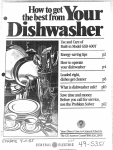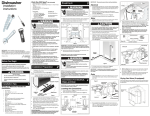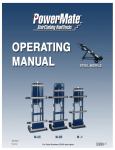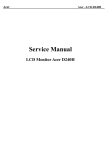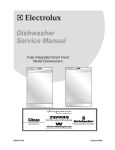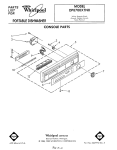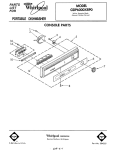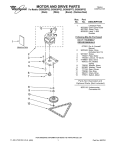Download GE GSS1800H Built
Transcript
Printed in USA 154430701 Before You Begin DO NOT INSTALL DISHWASHER UNTIL YOU HAVE READ ALL INSTRUCTIONS. Electrical Shock Hazard Disconnect electrical power at the fuse box or circuit breaker box before installing dishwasher. Failure to do so can result in death or electrical shock. Please read this book completely before you begin. These instructions will help you anticipate water, electrical, and drain connections, and will help you select the best location for your dishwasher. Installation tips are located on page 3. NOTE: Observe all local codes and ordinances for electrical and plumbing connections when installing your new dishwasher. All electrical and plumbing work should be performed by qualified persons. Plan the Installation Locate the dishwasher where there is easy access to existing water, drain, and electrical lines. Be sure the water inlet valve will be protected from freezing temperatures. If the valve freezes, flooding may occur. The best location for your dishwasher is on either side of the kitchen sink. This position should provide easy access to existing plumbing and will be convenient for loading items into the dishwasher once your dishwasher is installed. Tools You Will Need Level Measuring Tape Electric Drill Wire Stripper or Knife Flaring Tool (for copper tubing) Pipe Joint compound (for iron pipe plumbing) Tube Cutter (for copper tubing) 3 Keyhole Saw or 1 /2”, 1 1/2”, and 2” Hole Cutters /16”, 1/4”, and 5/16” Socket or Nut Driver Teflon® Tape (for iron pipe plumbing) 2 Adjustable Wrenches (for copper tubing) Pliers Slotted and Phillips Screwdrivers (magnetic tip preferred) 2 Pipe Wrenches (for iron pipe plumbing) Items You Will Need (Not Included) Drain Hose Clamp -1 1/4” Inner Diameter (ID) 90° Elbow - 3/8” National Pipe Thread Strain Relief Bushing Wire Nuts (2) 2 Installation Tips Read all instructions prior to installation • Water, electric, and drain connections are not the same for all age, brand, or models of dishwashers. Check and compare the location and length of your current utilities so you can plan your new installation (refer to pages 4 and 7). • Each home installation is different and some parts may be needed to meet your individual installation needs. You will need a 3/8” National Pipe Thread “Street L” or compatible right angle fittings (not included) to make the final water connections to the dishwasher valve (refer to page 8). • Clean dishes require an adequate supply of hot water. The water temperature must be between 120°F (49°C) and 150°F (66°C). A minimum water supply line of 3/8” (outside diameter) copper tubing is recommended. Reasonable water pressure is needed (20-120 PSI [pounds-per-square-inch]) flow rate minimum (2 gallons/minute) (refer to page 8). • A separate 15-20 amp, grounded 120V AC electrical supply is required for your new dishwasher. You may need a strain relief bushing and wire nuts or suitable connectors (not included) for connecting house wiring to the dishwasher. • If the dishwasher drain hose is connected to a garbage disposer for the first time, remember to knock out the plug in the disposer inlet. This plug is inside the inlet and you may not see the plug from the outside (refer to page 7). • The dishwasher drain hose to the house drain must have a 32” loop above the floor or a suitable air gap must be used to prevent water from siphoning out of the dishwasher and causing washing problems (refer to page 6). • Kinked water or drain lines can cause problems. Run lines with generous curves. Make sure lines are long enough to allow for generous curves. • Flush the water line prior to making final connections. A bunched towel over the end of the line can help prevent splashing. Let water drain into a bucket or pan. This will prevent premature clogging of the filter screen in the inlet valve. • The dishwasher will look, sound, and work better if it is properly leveled. Take time to adjust the leveling legs so that all of them touch the floor and the dishwasher is level. Use #8 x 5/8” Phillips head screws (supplied) to anchor dishwasher to countertop (refer to pages 9 and 13). 3 Location and Rough-In Figure 1 Most of the installation work should be done before the dishwasher is moved into place. First, select a location as close to the sink as possible for ready access to water and drain lines. For proper operation and appearance of the dishwasher, the cabinet opening should be square and have dimensions as shown in Figure 1. If the dishwasher is to be installed in a corner, there must be sufficient clearance to open the door as shown in Figure 2. A minimum clearance of 2” is recommended. Rough-in the water, electrical, and drain lines before proceeding with the installation. The lines should run straight to their connections on the dishwasher. Note: Make sure that the lines do not cross in front of the dishwasher motor or its legs. Figure 2 4 Preparing for Installation 1. Remove access panel assembly by opening door all the way and removing two (2) screws on top of access trim (see Figure 3). Figure 3 2. Close door. Remove two (2) bottom attach screws in access panel assembly. 3. The access panel assembly can now be removed by pulling it forward. Access Trim Screws 4. Install a 90° elbow (not included) into the water valve. Use Teflon® tape or joint compound to seal the elbow into the valve fitting. Valve fitting is 3/8” National Pipe Thread. Access Panel Assembly Adjustable Toeplate (not shown) Bottom Attach Screws Adjusting Door Spring Tension The door springs are set at the factory to the proper tension. To adjust spring tension, hook the springs in a frame hole to the back of their original settings (see Figure 4). Door Spring Door spring tension is correct when the door remains horizontal in the fully opened position, yet rises to a close with the slight lift of a finger. Front of Dishwasher Frame Holes Move spring to rear of dishwasher to increase tension Figure 4 Side Panel Kit The dishwasher is not provided with a complete enclosure. If the dishwasher is to be installed at the end of a cabinet line, be certain that the sides and the back are fully enclosed (see Figure 5). Side panel kits are available from your dealer or distributor. Figure 5 5 Locating Drain, Water, and Electrical Supplies Before you begin, review this section in detail. Check your location to make sure you have the right drain, water, and electrical supplies to make these connections. Refer to the dimensional details in Figure 6 to help you decide where to run the drain, water, and electrical lines. All connections must be made in the shaded area as shown in Figure 1 on page 4. NOTE: Make sure that no lines cross in front of the dishwasher’s motor or legs. Front View Left Side View 24 1/2” 17 3/ 4 ” Door in Open Position Right Side View 47 7/8” 22 1/2” To Tub Flange 34” to 35” Max. Floor Line 18” Center Line of Water Valve 13” Center of Water Valve 21” From rear to Electrical Junction Box. 11” Center Line of Motor Figure 6 Drain Review Figures 7 and 8 to determine where you will connect the dishwasher to the drain system. Cut a 2” diameter drain hose hole in the shaded area shown in Figure 1 on page 4. Check both sides of the area BEFORE cutting to avoid interference. If the cabinet wall is wooden, sand the edges of the hole until it is smooth and rounded. If the cabinet wall is metal, all sharp edges MUST be covered by a protective material such as electrical tape or duct tape to avoid cutting the drain hose. Local codes may require the drain line to be connected to house plumbing with a drain air gap. If the drain hose is to be connected to a separate drain trap, the trap must be vented with a drain air gap to prevent siphoning. A drain loop must be fixed (with a suitable clamp or support) at a minimum height of 32” from the floor. When routing the drain hose, be sure there are no sharp bends or kinks that might restrict drain flow. Proceed as follows: 1. Route the hose from the dishwasher cabinet through the 2” drain hose hole you have cut for it. 2. Support or clamp the drain hose so that the loop is at a minimum height of 32”. 3. Use a drain hose clamp (not included) to connect the hose to the sink drain or disposer. Do not connect the hose to the horizontal pipe between the sink drain and the garbage disposer. Entry into sink drain must be above trap. Be careful not to over tighten the clamp or you may damage the end of the hose. 6 • If you connect to a sink drain, using the “Y” Branch Tailpiece and Connector Kit, available at plumbing and hardware stores, will make this connection easier. The kit includes all of the necessary fittings and complete installation instructions. • If you connect to a disposer, use the larger end of the corrugated hose which has been designed to fit the disposer without any special connectors (see inset of Figure 7). NOTE: Be sure to remove the knockout plug from inside the disposer inlet fitting before attaching the drain hose. If the drain hose is to be routed through the floor to a separate trap, the trap must be vented to prevent siphoning. To provide proper venting, install the Air Gap Kit, available at plumbing and hardware stores, into the countertop. Route the drain hose up to the inlet side of the air gap. Continue drain line from outlet side of air gap down through floor to separate trap (see Figure 8). Do not cut the corrugated drain hose. Excess corrugated hose should be placed flat on the floor in the dishwasher cabinet. Make sure the hose does not come into contact with any sharp edges. Connecting to a Sink Drain Entry Must be Above Trap “Y” Branch Tailpiece Figure 7 Sink at Left Sink at Right Drain Motor End Cut for 5/8” connection. 2” Drain Hose Hole Larger end of hose fits disposer inlet fitting. Drain Hose Cut for 3/4” connection. Drain Air Gap Connecting to a Disposer Alternate Drain Through Floor into Separate Trap Figure 8 Remove Knockout Plug in Disposer Sink at Right 2” Drain Hose Hole Sink at Left 7 Water Determine where you will connect the dishwasher to the hot water supply. Review Figure 6 on page 6 and note the location of the water valve. Water temperature limits are 120°F minimum and 150°F maximum (49°C 66°C). The dishwasher water inlet valve has a 3/8” National Pipe Thread female fitting. Determine how much copper tubing will be required. Copper tubing must have a minimum outside diameter of 3/8”. High-pressure rated plastic tubing with a minimum inner diameter of 1/4” may be used where local plumbing codes permit. It is recommended that a shut-off valve be installed outside the dishwasher cabinet. Water pressure should be between 20 and 120 PSI (pound per square inch). Cut the water access hole in the shaded area as shown in Figure 1 on page 4. Complete the plumbing rough-in before putting the dishwasher into place. Note: The furnished drain hose must not be used as a water supply line. Do not use a rubber garden hose for water supply line. Either one of these hoses will burst. Electrical Power Supply The dishwasher operates on a 120VAC 60Hz fused electrical supply. Provide a separate circuit with a fuse or circuit breaker rated for at least 15 amps, 20 amps if connected with disposer, but not more than 20 amps. Electrical Shock Hazard Electrically ground dishwasher. Connect grounding wire to green grounding nut in terminal box. Fire Hazard Do not use an extension cord. Failure to do so can result in death, or electrical shock. Failure to do so can result in death or electrical shock. Grounding Instructions This appliance must be connected to a grounded metal fixture or to a permanent wiring system, or an equipment grounding conductor must be run with the circuit conductors and connected to the equipment grounding terminal or lead on the appliance. Do not connect the dishwasher to the electrical supply until the appliance is permanently grounded. Grounding must be in accordance with the National Electrical Code and local codes and ordinances. Note: This unit is provided with stranded copper wire with coating to prevent corrosion. Connect with copper wire only. Determine where you will connect to the electrical supply. Note the location of the electrical junction box in Figure 6 on page 6. Cut the access hole in the shaded area shown in Figure 1 on page 4. Pull electrical cable through into the cabinet area through the access hole. After the dishwasher has been positioned inside the cabinet, the electrical connections can be made. 8 Position, Align, and Level the Dishwasher Tip Over Hazard Do not use dishwasher until completely installed. Do not push down on open door. Doing so can result in serious injury or cuts. Before moving the dishwasher into the opening: • Adjust the front levelers so the top of the machine is 1/4” below the underside of the countertop (see Figure 9). • Using a hex end wrench or 3/16” socket, adjust rear levelers to level the dishwasher from front to back. You can now move the dishwasher into the opening and align it with the cabinets. Use caution when moving the appliance to prevent damage to floor coverings and adjacent cabinets. • Align the front of the dishwasher as flush as possible with front of the cabinets. • Align the dishwasher so that the amount of space is the same on each side and the same from top to bottom. NOTE: Double check the levelers to make sure they set firmly against the floor. Leveling is necessary for proper function of the dishwasher. Hex End Wrench or 3 /16” Socket You are now ready to proceed with the final drain, water, and electrical connections. Figure 9 Drain Hose Routing Be sure the hose is routed behind the dishwasher motor and legs (see Figure 10). Place the excess hose flat on the floor in the dishwasher opening. NOTE: Be sure there are no sharp bends, kinks, or twists in the drain hose. Electrical Shock Hazard Disconnect electrical power at the fuse box or circuit breaker box before installing dishwasher. Make sure that the water supply line, drain hose, and wiring do not touch any exposed terminals of the dishwasher wiring. Failure to follow these instructions could result in death or serious injury. Drain Hose Motor Dishwasher Leg Figure 10 9 Water Line Connection Install accessible in-line shutoff valve. Route the water pipe or tubing as shown (see Figure 11), straight forward from the back to the inlet valve. Pipe or tubing must not be kinked. It must be free of scales, chips, lubricants, etc. before it is connected to the inlet valve. Flush the water line before connecting it to the valve. Through Wall If the water valve clogs with foreign material, turn off the water supply, then remove the four (4) screws at the inlet end of the valve for access to the filter screen. Through Floor Note: Do not solder too close to the water valve. Overheating of the valve will damage plastic parts in the valve. Use care that no sealer, dirt, or foreign material can enter valve. Through Cabinet The furnished drain hose must not be used as a water supply line. Figure 11 Be sure the dishwasher is placed where the water valve is protected from freezing temperatures. If the valve freezes, flooding may occur. Install Power Cord (when used) For power cord installation only. Skip this step if dishwasher will be directly wired. Strain Relief Connector Remove the junction box cover and install strain relief and power cord. The power cord and connections must comply with the National Electrical Code, Section 422 and/or local codes and ordinances. The cord must be no longer than 6 ft. from the junction box to the receptacle. Junction Box Green Grounding Wire and Screw Black Wire to Black Wire (Hot) Locate the two dishwasher wires (white and black) with the stripped ends. Using UL Listed wire nuts of appropriate size, connect incoming white to white and black to black. Connect the ground wire to green grounding screw. Replace the junction box cover. Check that wires are not pinched under cover. Relief Bushing White Wire to White Wire (Neutral) Junction Box Cover 10 Figure 12 Connect Dishwasher to Electrical Supply The appliance MUST be permanently grounded in accordance with the National Electrical Code and local codes and ordinances. Electrical Shock Hazard Disconnect electrical power at the fuse box or circuit breaker box before installing dishwasher. Failure to do so can result in death or electrical shock. 1. Remove the junction box cover (see Figure 13). 2. Pull the house wiring in the cabinet area forward to the junction box. Be sure the electrical cable is behind the dishwasher motor and rear legs. Use a UL listed strain relief connector (not included) at the box. 3. In the junction box, connect the incoming black lead to the dishwasher’s black lead with wire nuts or suitable connectors (not included). Next, connect the incoming white lead to the dishwasher’s white lead with wire nuts or suitable connectors (not included). 4. Attach grounding wire under head of green grounding screw and tighten screw. 5. Replace the junction box cover. Through Wall Through Cabinet Strain Relief Connector Green Grounding Wire and Screw Junction Box Through Floor Junction Box Black Wire to Black Wire (Hot) Relief Bushing White Wire to White Wire (Neutral) Figure 13 Junction Box Cover 11 Secure Dishwasher in Opening The dishwasher must be secured to keep it from tilting when the door is opened. Choose one of the two methods described below for securing the dishwasher. Countertop Anchoring: 1. If necessary, adjust leveling screws so mounting brackets touch the underside of the countertop (see Figure 14). 2. Screw the mounting brackets firmly to the countertop using #8 x 5/8” Phillips head screws (supplied). Note: Check levelers to make sure weight of dishwasher rests on floor. 3. Open and close the dishwasher door slowly. If the door hits the mounting bracket screw heads, adjust front leveling legs. Floor Anchoring: This is a difficult procedure. Use only where the countertop mounting brackets cannot be used. 1. Screw 1/4” lag screws (not included) through the holes provided in the frame rail (see Figure 14). 2. Use expansion fasteners if the floor is concrete. Countertop Anchoring Mounting Brackets Use #8 X 5/8” Phillips head screws (supplied). Figure 14 Floor Anchoring with /4” Lag Screws 1 Hex End Wrench or 3/16” Socket To Install Custom Wood Panels The dishwasher door and access panel can be customized to match wood cabinets. This will require a wood panel trim kit. Kit is available from your dealer or parts supplier—kit number GPF18. 12 Operate the Dishwasher Before you start your dishwasher, check the following: • Dishwasher is level and securely fastened in place. • Open and close door to make sure it does not hit surrounding cabinet or countertop. • Water supply is turned on. • No leaking from joints. • All wire connections are tight. • Electricity is turned on. • No kinks in water or drain lines. • All packing material and customer literature have been taken out of the dishwasher. Operate the machine through at least one fill and pump-out. • Check water level after dishwasher has filled completely. Water should fill to the heating element. • Check for satisfactory pump-out. At end of pump-out, a small amount of water in the bottom of the tub is normal. • Check for leaks. If operation is satisfactory, replace the access panel assembly. NOTE to INSTALLER: Put installation instructions back in the literature packet and leave with dishwasher so all information will be readily available to user. NOTE to OWNER: Please read the dishwasher Owner’s Manual. It contains important safety information for those operating the appliance. It also contains many suggestions for obtaining the best results from your dishwasher. 13 14 15 SPECIFICATIONS SUBJECT TO CHANGE WITHOUT NOTICE. Pub. No. 31-30550 16

















